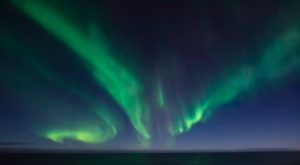What are the Northern Lights?
August 24, 2016 - 1 minute read Just about everyone has heard of the Aurora Borealis (Northern Lights) but what exactly are those giant green illuminations that often shimmer above Arctic regions after dark?
Just about everyone has heard of the Aurora Borealis (Northern Lights) but what exactly are those giant green illuminations that often shimmer above Arctic regions after dark?
According to the National Oceanic and Atmospheric Administration (NOAA), the Aurora Borealis — and its southern hemisphere counterpart, the Aurora Australis or Southern Lights — are the result of electrons colliding with the upper reaches of Earth’s atmosphere. The accelerated electrons follow the planet’s magnetic field to the polar regions where they collide with oxygen and nitrogen atoms and molecules. When the atoms and molecules relax back down to lower energy states, they release their energy in the form of light in a manner similar to neon lights.
The best place to observe the aurora is between the north and south latitudes of 60 and 75 degrees. As both Iceland and the lower half of Greenland fall within this range, the Northern Lights appear above these places more than half of the nights during a given year.
The NOAA publishes a handy Aurora Viewing Guide on its website. Or you can check out this video courtesy of the Science Channel — https://www.facebook.com/ScienceChannel/videos/10154553875698586/
0 Comments